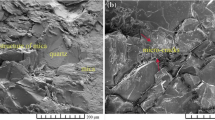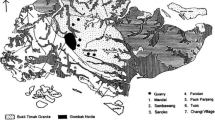Abstract
This work presents an experiment on the acoustic emission (AE) of coarse grain granites with two square-shaped precut holes under uniaxial loading. Studies were carried out on the temporal–spatial evolution behavior of micro-cracks by AE mechanisms with the use of the simplex location method and the moment tensor theory, with further analysis in comparing the numerical simulations using the software RFPA\(^\mathrm{2D}\) (Rock Failure Process Analysis). The results show that during the loading process, from beginning to rock failure, shear-mode micro-cracks are prominent, constituting more than 60 % of the total events; next most common are tensile-mode micro-cracks a less than 35 % of the total events. Variations of micro-cracks of the three modes during the loading process have the same increase tendency, i.e. fewer were generated in the initial loading stage, with a rapid increase when the stress values are between 40 and 60 % of the peak stress, and a rate dimunition before rock failure. It is observed that the tensile stress concentration is prone to appear at the tops of the two holes in the form of tensile type cracks, while the shear stress concentration usually appears at the bottom in the middle region of the specimen in the form of shear type cracks. The findings of the present work may serve as guidance for the prevention of roof and floor collapse in the stope exploration of mines.








Similar content being viewed by others
References
Aki K, Richards PG (1980) Quantitative seismology: theory and methods. W.H. Freeman, San Francisco
Chang SH, Lee CI (2004) Estimation of cracking and damage mechanisms in rock under triaxial compression by moment tensor analysis of acoustic emission. Int J Rock Mech Min Sci 41:1069–1086
Dresen G, Stanchits S, Rybacki E (2010) Borehole breakout evolution through acoustic emission location analysis. Int J Rock Mech Min Sci 47:426–435
Gilbert F (1971) Excitation of the normal modes of the earth by earthquake sources. Geophys J Int 22:223–226
Graham CC, Stanchits S, Main IG, Dresen G (2010) Comparison of polarity and moment tensor inversion methods for source analysis of acoustic emission data. Int J Rock Mech Min Sci 47:161–169
Hirata A, Kameoka Y, Hirano T (2007) Safety management based on detection of possible rock bursts by AE monitoring during tunnel excavation. Rock Mech Rock Eng 40:563–576
Katsaga T, Sherwood EG, Collins MP, Young RP (2007) Acoustic emission imaging of shear failure in large reinforced concrete structures. Int J Fract 148:29–45
Lei XL, Nishizawa O, Kusunose K, Satoh T (1992) Fractal structure of the hypocenter distributions and focal mechanism solutions of acoustic emission in two granites of different grain sizes. J Phys Earth 40:617–634
Lei XL, Satoh T (2007) Indicators of critical point behavior prior to rock failure inferred from pre-failure damage. J Tectonophys 431:97–111
Li YH, Liu JP, Zhao XD, Yang YJ (2010) Experimental studies of the change of spatial correlation length of acoustic emission events during rock fracture process. Int J Rock Mech Min Sci 47:1254–1262
Liu JP, Xu SD, Li YH, Dong LB, Wei J (2012) Studies of AE time-space evolution characteristics during failure process of rock specimens with prefabricated holes. Chin J Rock Mech Eng 31:2538–3547
Lockner D (1993) The role of acoustic emission in the study of rock fracture. Int J Rock Mech Min Sci Geomech Abstr 30:883–899
Manthei G, Eisenblatter J, Dahm T (2011) Moment tensor evaluation of acoustic emission sources in salt rock. Constr Build Mater 15:297–309
Mogi K (1962) Magnitude-frequency relation for elastic shocks accompanying fractures of various materials and some related problems in earthquakes. Bull Earthq Res Inst 40:831–853
Ohno K, Ohtsu M (2010) Crack classification in concrete based on acoustic emission. Constr Build Mater 24:2339–2346
Ohtsu M (1991) Simplified moment tensor analysis and unified decomposition of acoustic emission source: application to in situ hydro fracturing test. J Geophys Res 96:6211–6221
Ohtsu M (1995) Acoustic emission theory for moment tensor analysis. J Res Nondestruct Eval 6:169–184
Rabinowitz N, Kulhanek O (1988) Application of a nonlinear algorithm to teleseismic locations using P-wave readings from the Swedish seismographic network. Phys Earth Planet Inter 50:111–115
Scholz CH (1968) The frequency–magnitude relation of microfracturing in rock and its relation to earthquakes. Bull Seismol Soc Am 58:399–415
Tang CA (1997) Numerical simulation of progressive rock failure and associated seismicity. Int J Rock Mech Min Sci 34:249–261
Xu S, Liu JP, Xu SD, Wei J, Huang WB (2012) Experimental studies on pillar failure characteristics based on acoustic emission location technique. Trans Nonferr Metals Soc China 22:2792–2798
Zang A, Wagner C, Stanchits S, Dresen G, Andresen R, Haidekker MA (1998) Source analysis of acoustic emission in Aue granite cores under symmetric and asymmetric compressive loads. Geophys J Int 135:1113–1130
Acknowledgments
This work was financially supported by the Projects (2013BAB02B01) of the Key Projects of the National Science & Technology Pillar Program of China, the Projects (51274055, 51204030) of the National Natural Science Foundation of China, and the Projects (N130401006, N120801002, N120701001) of the Fundamental Research Funds for the Central University of China.
Author information
Authors and Affiliations
Corresponding author
Rights and permissions
About this article
Cite this article
Liu, Jp., Li, Yh. & Xu, Sd. Estimation of cracking and damage mechanisms of rock specimens with precut holes by moment tensor analysis of acoustic emission. Int J Fract 188, 1–8 (2014). https://doi.org/10.1007/s10704-014-9940-x
Received:
Accepted:
Published:
Issue Date:
DOI: https://doi.org/10.1007/s10704-014-9940-x




